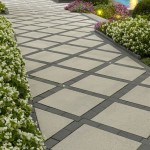How To Lay Patio Tiles On Dirt: A Comprehensive Guide
Creating a patio can significantly enhance outdoor living spaces, providing an area for relaxation, entertainment, and al fresco dining. While traditional patios are often constructed on concrete slabs, laying patio tiles directly on a dirt base is a viable option for certain applications. This approach, however, requires careful planning and meticulous execution to ensure a stable, durable, and aesthetically pleasing result. This article provides a detailed guide on how to lay patio tiles on dirt, covering essential steps, considerations, and best practices.
Before embarking on the project, it is crucial to thoroughly assess the existing conditions of the site. Consider the soil type, drainage capabilities, and the intended use of the patio. Understanding these factors will influence material selection, preparation techniques, and overall construction methodology. Improper planning can lead to issues such as tile instability, uneven surfaces, and premature deterioration.
Key Point 1: Site Preparation and Excavation
The initial phase of laying patio tiles on dirt involves thorough site preparation. This step is fundamental in establishing a solid foundation for the tiles and preventing future problems related to settling or movement. The process typically begins with defining the desired patio area and marking the boundaries using stakes and string.
Once the perimeter is established, excavation is required to remove the existing topsoil. The depth of excavation will depend on the desired finished patio height and the thickness of the base materials. A general guideline is to excavate a minimum of 6 inches, but deeper excavation may be necessary in areas with poor soil conditions or where a thicker base is desired. The removed topsoil can be repurposed in other areas of the garden or landscape.
During excavation, it is important to maintain a consistent grade and slope for proper drainage. A slight slope of approximately 1/4 inch per foot away from any buildings or structures is recommended to prevent water from pooling on the patio surface. This can be achieved using a level and grading tools to ensure accuracy. After excavation, the soil should be compacted using a plate compactor to create a firm and stable base.
Following compaction, a layer of landscape fabric should be laid over the excavated area. This fabric serves as a barrier to prevent weeds from growing through the tiles and helps to stabilize the soil. Overlapping the edges of the fabric by at least 12 inches ensures complete coverage and prevents gaps where weeds could potentially emerge. The landscape fabric should be secured in place with landscape staples to prevent it from shifting during subsequent steps.
The next step involves adding a base layer of crushed stone or gravel. This layer provides a stable and well-draining foundation for the patio tiles. A recommended thickness for the base layer is 4 to 6 inches, depending on the soil conditions and the intended use of the patio. The crushed stone should be spread evenly and compacted thoroughly using a plate compactor. Compaction is crucial to ensure that the base layer is dense and stable, preventing settling or movement of the patio tiles.
After compacting the crushed stone, a layer of leveling sand should be added. This sand layer, typically 1 to 2 inches thick, provides a smooth and consistent surface for laying the tiles. The sand should be spread evenly and screeded to create a perfectly level surface. A long, straight board can be used to screed the sand, ensuring that the surface is flat and free of any bumps or dips. It is important to note that the leveling sand should be damp, but not saturated, to facilitate compaction and prevent it from shifting during tile installation.
Key Point 2: Tile Selection and Installation
Selecting the appropriate type of patio tiles is crucial for ensuring durability, aesthetics, and longevity. Various types of tiles are available, including concrete pavers, natural stone, brick, and porcelain tiles. Each material has its own unique characteristics, advantages, and disadvantages. Considerations such as cost, aesthetics, durability, and maintenance requirements should be taken into account when making a selection.
Concrete pavers are a popular choice for patios due to their affordability, durability, and wide range of styles and colors. They are relatively easy to install and require minimal maintenance. Natural stone tiles, such as flagstone or slate, offer a more natural and aesthetically pleasing look. However, they can be more expensive and require more specialized installation techniques. Brick tiles are a classic choice for patios, offering a traditional and timeless look. They are durable and relatively easy to maintain, but can be more prone to cracking in freeze-thaw climates. Porcelain tiles are a durable and low-maintenance option that is resistant to staining and fading. They are available in a wide range of styles and colors, making them a versatile choice for patios.
Before starting the tile installation, it is important to plan the layout and pattern of the tiles. This will help to ensure that the finished patio looks aesthetically pleasing and that the tiles are properly aligned. The layout should be carefully considered to minimize cuts and waste, and to create a visually appealing pattern. It is often helpful to dry-lay the tiles in the desired pattern before permanently installing them to ensure that the layout is satisfactory.
When installing the tiles, it is important to maintain consistent spacing between them. This can be achieved using tile spacers, which are small plastic pieces that are inserted between the tiles to ensure uniform gaps. The recommended spacing will depend on the size and type of tile, but a general guideline is 1/4 inch to 3/8 inch. The tiles should be firmly pressed into the leveling sand, ensuring that they are level and properly supported. A rubber mallet can be used to gently tap the tiles into place, ensuring that they are fully seated in the sand.
As the tiles are installed, it is important to regularly check the level and alignment. A level can be used to ensure that the tiles are perfectly flat, and a straightedge can be used to ensure that they are properly aligned. Any adjustments should be made promptly to prevent problems from compounding as the installation progresses. If any tiles are cracked or damaged, they should be replaced immediately to prevent further damage or instability.
Cutting tiles will likely be necessary to fit the patio to its boundaries or to accommodate obstacles such as steps or planters. A wet saw or tile cutter can be used to make clean and accurate cuts. It is important to wear safety glasses and gloves when cutting tiles to protect against injury. The cut edges of the tiles should be smooth and free of any sharp edges.
Key Point 3: Joint Filling and Finishing
Once all the tiles have been installed, the joints between them need to be filled with a jointing compound. This compound serves to stabilize the tiles, prevent weeds from growing between them, and enhance the overall appearance of the patio. Various types of jointing compounds are available, including polymeric sand, mortar, and gravel. The selection of the appropriate jointing compound will depend on the type of tile, the width of the joints, and the desired aesthetic.
Polymeric sand is a popular choice for filling joints between patio tiles. It is a mixture of sand and polymers that hardens when exposed to water, creating a durable and weed-resistant joint. To apply polymeric sand, it should be poured over the tiles and swept into the joints using a broom. It is important to ensure that the joints are completely filled and that the sand is compacted firmly. After the joints are filled, the patio should be lightly watered to activate the polymers and harden the sand.
Mortar is a traditional choice for filling joints between brick or natural stone tiles. It is a mixture of cement, sand, and water that hardens to create a strong and durable joint. To apply mortar, it should be mixed to a consistency similar to peanut butter and applied to the joints using a trowel. The mortar should be pressed firmly into the joints and the excess should be wiped away with a damp sponge. It is important to allow the mortar to cure properly before exposing the patio to heavy use.
Gravel is a simple and cost-effective option for filling joints between patio tiles. It is particularly well-suited for patios with wide joints or for rustic-style patios. To apply gravel, it should be poured over the tiles and swept into the joints using a broom. It is important to ensure that the gravel is evenly distributed and that the joints are completely filled.
After the joints have been filled, the patio should be thoroughly cleaned to remove any excess jointing compound or debris. A broom or hose can be used to sweep or wash away any loose material. It is important to allow the patio to dry completely before using it. Once the patio is dry, it can be sealed with a sealant to protect it from staining and weathering. A sealant will also enhance the color and appearance of the tiles, making them more vibrant and attractive.
Regular maintenance is essential to keep the patio looking its best and to extend its lifespan. This includes sweeping or washing the patio regularly to remove dirt and debris, and occasionally applying a sealant to protect it from staining and weathering. Any weeds that grow between the tiles should be removed promptly, and any cracked or damaged tiles should be replaced immediately. With proper care and maintenance, a patio laid on dirt can provide years of enjoyment and enhance the beauty and functionality of outdoor living spaces.

Outdoor Flooring Over Grass Or Dirt Interlocking Tiles

How To Install Deck Tiles For A Quick And Easy Patio

How To Install Deck Tiles For A Quick And Easy Patio

How To Lay Pavers On Sand Or Dirt Premier Stone

Outdoor Flooring Over Grass Or Dirt Interlocking Tiles

How To Install Deck Tiles For A Quick And Easy Patio

Dry Laying Slabs On Gravel Or Sand Instruction Kronos Ceramiche Floor Coverings In Porcelain Stoneware

How To Lay Outdoor Tiles On Gravel Or Sand Patio Flooring

How To Install Porcelain Pavers Arrak
Enjoy It By Elise Blaha Cripe Backyard Progress
Related Posts








